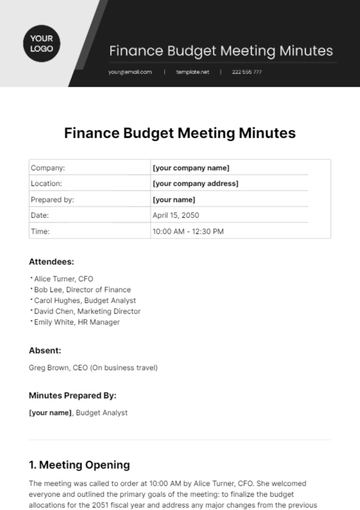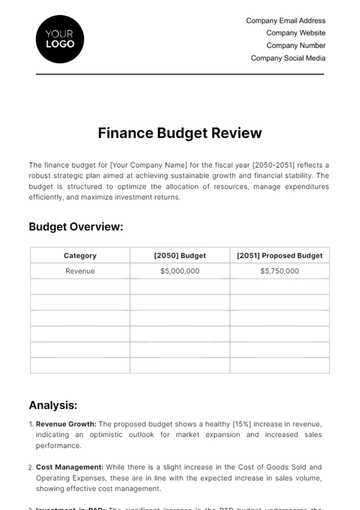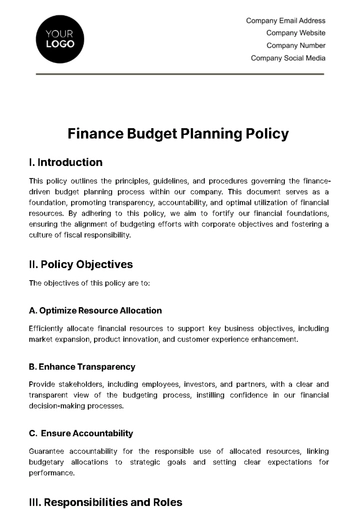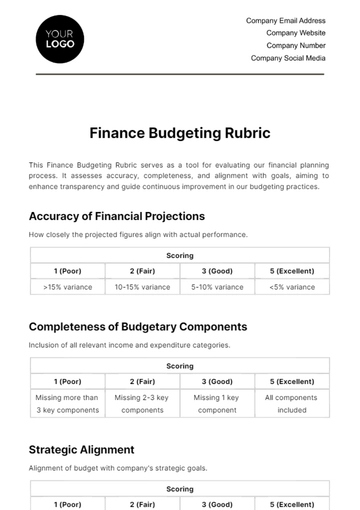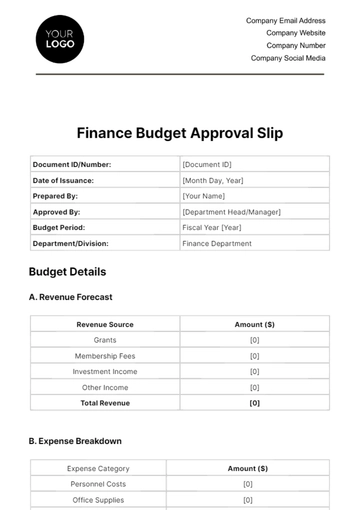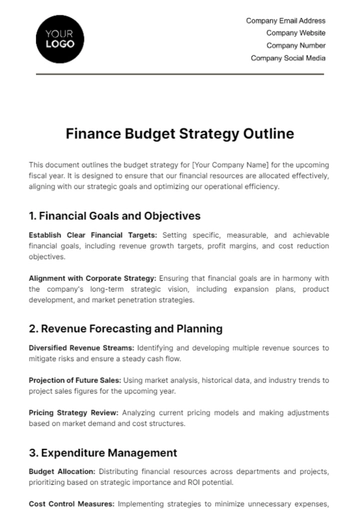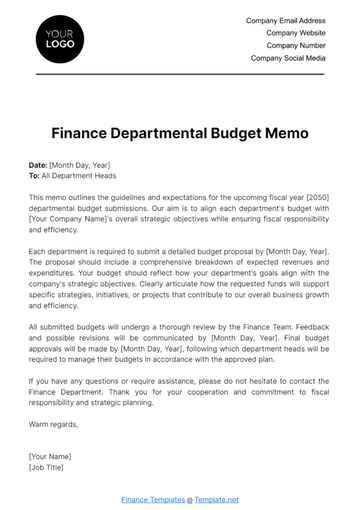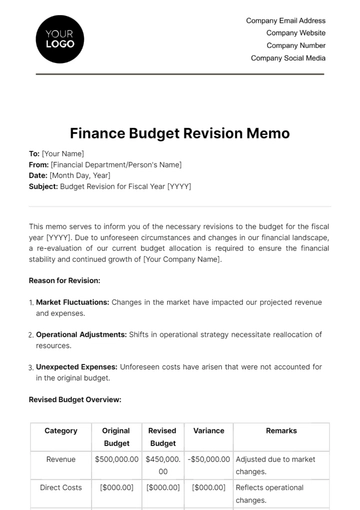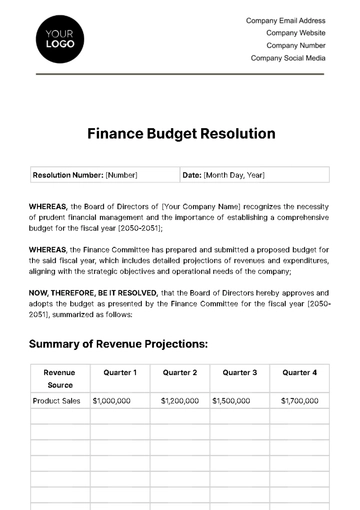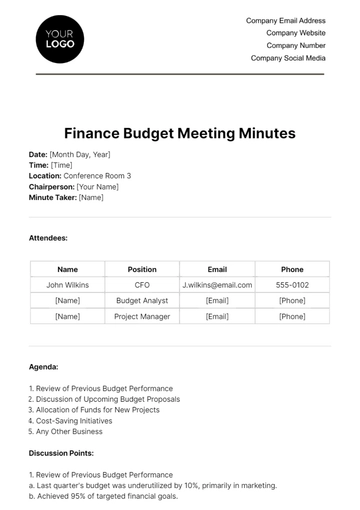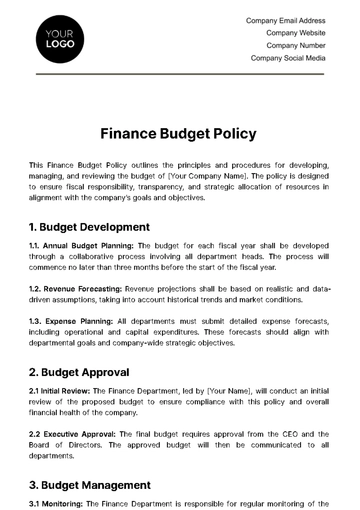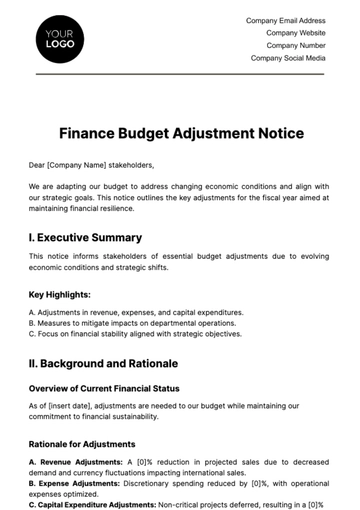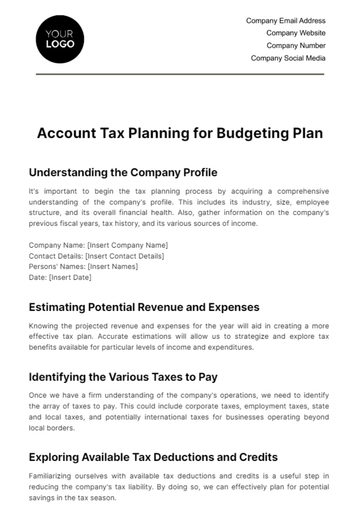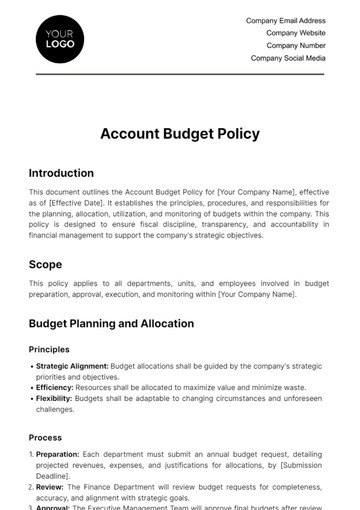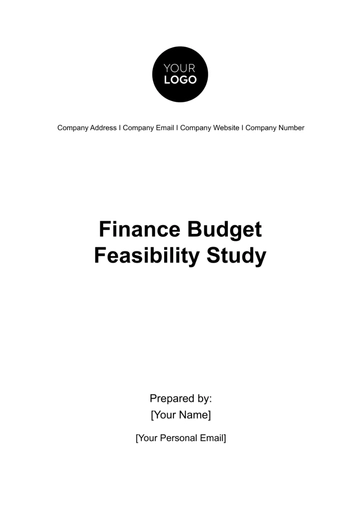Free Finance Budget Strategy Management
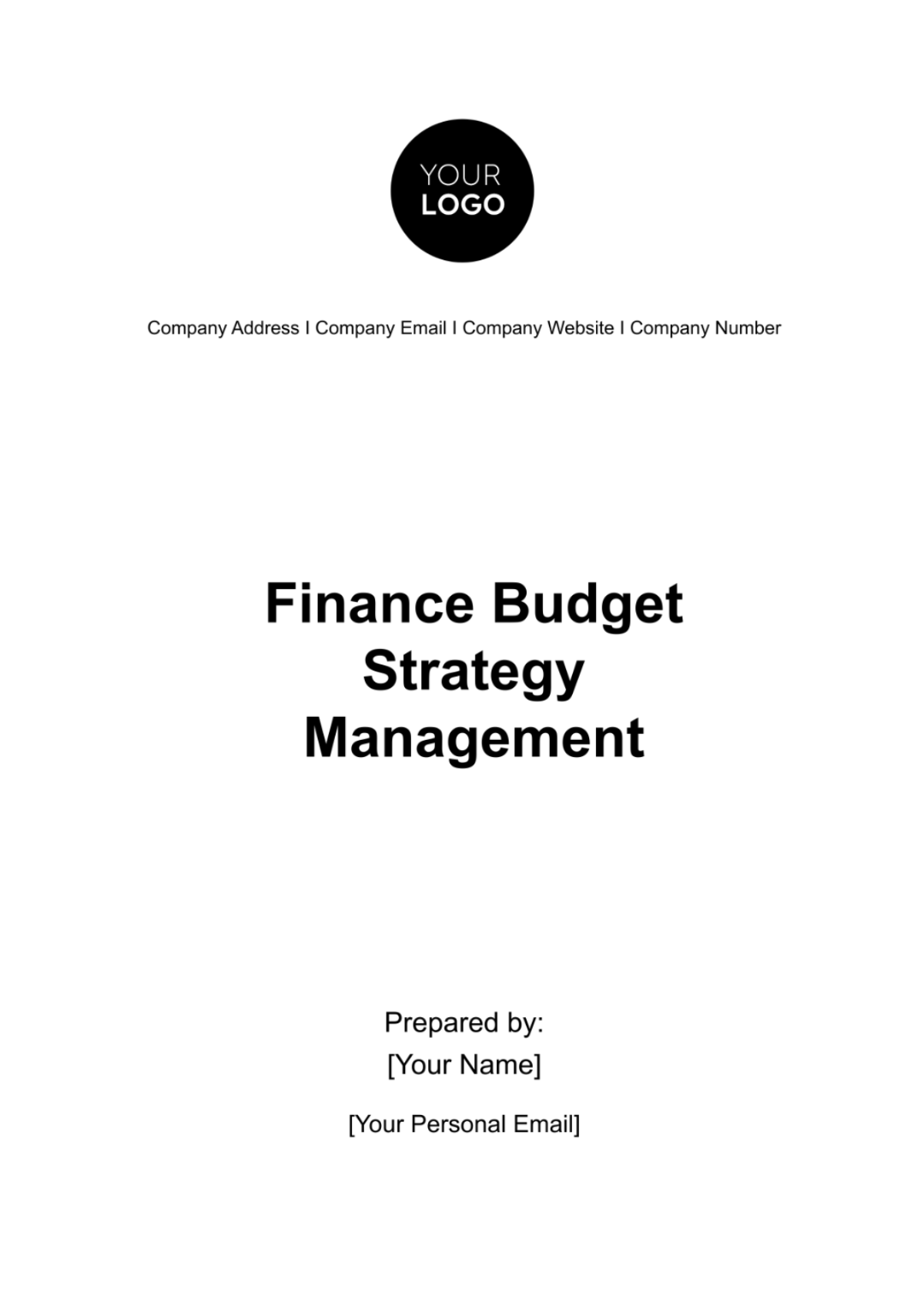
1. Executive Summary
This Finance Budget Strategy Management document presents a detailed and strategic approach tailored for [Your Company Name] to optimize its financial resources and enhance overall fiscal performance. Aimed at fostering sustainable growth, this plan encapsulates a multi-faceted approach, addressing key financial objectives, comprehensive budget strategies, cash flow management, performance metrics, risk management, and a structured review and adjustment framework.
At the core of this strategy is the ambition to drive revenue growth, a goal underpinned by diversifying product lines and expanding into new markets. This is complemented by a rigorous cost management plan, focused on minimizing operational expenses through enhanced process efficiencies and strategic vendor negotiations. Recognizing the importance of investment in growth, the document lays out a clear roadmap for capital expenditure, balancing the need for immediate operational efficiency with long-term strategic investments.
The document's budget strategy is meticulously designed, incorporating detailed monthly revenue forecasts and a well-structured expense budget. Each category of expenditure is carefully analyzed to ensure alignment with overall business objectives, ensuring financial resources are allocated efficiently. The capital expenditure section provides a clear overview of planned investments, emphasizing their purpose and expected returns, thus ensuring a strategic approach to asset management.
Cash flow management is addressed with a proactive stance, highlighting the importance of maintaining a healthy cash flow through strategies like faster invoice processing and optimized inventory management. This is crucial for maintaining operational stability and funding growth initiatives.
Performance metrics form a backbone of the strategy, offering quantifiable targets for profitability, liquidity, and financial leverage. These metrics not only provide benchmarks for success but also serve as vital indicators for ongoing financial health monitoring.
Risk management is approached with a comprehensive risk assessment, identifying potential financial threats and outlining effective mitigation strategies. This proactive approach is essential in safeguarding the company against unforeseen financial challenges.
Finally, the document emphasizes the importance of adaptability through its review and adjustment plan. Regular financial performance reviews are scheduled, ensuring that the financial strategy remains relevant and effective in the dynamic business environment.
Overall, this Finance Budget Strategy Management document is a robust framework for [Your Company Name], designed to ensure financial stability, drive growth, and enhance shareholder value. By adhering to this well-structured plan, [Your Company Name] is poised to achieve its financial objectives and solidify its market position.
2. Financial Objectives
The chapter outlines the specific financial objectives for [Your Company Name], which form the cornerstone of our broader Finance Budget Strategy Management plan. These objectives are designed to guide the company towards measurable financial success, aligning with our overarching goal of enhancing profitability, reducing costs, and optimizing capital efficiency. Each objective is accompanied by a clear description, a quantifiable target, and a defined time frame, ensuring accountability and focus. By setting these objectives, [Your Company Name] commits to a path of disciplined financial management and strategic growth.
A. Revenue Growth: The goal here is to expand the company's market reach and diversify its product offerings. This strategy is expected to result in a [0]% increase in total revenue over the next year. This growth will be driven by both expanding into new markets and innovating within existing product lines.
B. Cost Reduction: By focusing on process optimization and renegotiating terms with vendors, [Your Company Name] aims to reduce its operational expenses by [0]% within the next six months. These savings will come from efficiencies in production, supply chain management, and administrative processes.
C. Capital Efficiency: The third objective is to maximize the returns on capital investments. This involves not just careful selection of investment opportunities but also ensuring that existing assets are utilized to their fullest potential. The target is to enhance the return on investment (ROI) by [0]% over the course of the next year, which will be achieved by optimizing asset usage and strategically allocating capital towards high-return projects.
Through the execution of these well-defined financial objectives, [Your Company Name] is set to strengthen its financial foundation, fuel growth, and increase shareholder value. Each objective is designed to be challenging yet achievable, ensuring that the company continuously strives for excellence in its financial operations.
3. Budget Strategy
This chapter presents the detailed Budget Strategy for [Your Company Name], a key component in our Finance Budget Strategy Management plan. It comprises three main sections: Revenue Forecast, Expense Budget, and Capital Expenditure. These sections collectively provide a comprehensive view of our anticipated financial activities for the upcoming fiscal year. By meticulously planning and forecasting these elements, we aim to ensure that our financial resources are aligned with our strategic goals, thereby facilitating informed decision-making and efficient resource allocation.
3.1 Revenue Forecast
The Revenue Forecast section outlines our monthly revenue projections, highlighting expected growth rates. These figures are crucial for understanding our financial trajectory and planning for both short-term operations and long-term investments.
Month | Projected Revenue | Growth Rate |
|---|---|---|
Jan | $120,000 | 5% |
Feb | $125,000 | 4.2% |
3.2 Expense Budget
The Expense Budget provides a detailed breakdown of our planned expenditures in key areas. This helps in ensuring that our spending is in line with our strategic priorities.
Category | Budget Allocation | Notes |
|---|---|---|
Salaries | $500,000 | Based on current staffing levels |
Marketing | $200,000 | Includes digital and traditional marketing |
3.3 Capital Expenditure
This section lists significant capital investments planned for the year, specifying their cost and purpose. These investments are crucial for long-term growth and efficiency improvements.
Item | Cost | Purpose |
|---|---|---|
Equipment | $400,000 | For production expansion |
Software | $100,000 | To improve operational efficiency |
4. Cash Flow Management
Effective cash flow management is vital for the financial stability and operational efficiency of [Your Company Name]. This chapter outlines our strategies and practices designed to enhance our cash flow position in the upcoming fiscal year. A detailed cash flow projection for this period is provided in Appendix A, offering a month-by-month forecast of cash inflows and outflows.
Key Strategies for Cash Flow Improvement:
Faster Invoice Turnover:
Implementation of Electronic Invoicing: Transition to an electronic invoicing system to expedite the billing process. This system will reduce errors, speed up the delivery of invoices, and enable faster payment processing.
Incentives for Early Payment: Offer discounts or other incentives to customers who pay their invoices ahead of the due date. This approach encourages quicker payments, improving our cash inflows.
Optimizing Inventory Levels:
Just-In-Time Inventory (JIT): Adopt a JIT inventory system to reduce holding costs and minimize the capital tied up in inventory. This approach involves maintaining inventory levels that are closely aligned with production schedules and customer orders.
Regular Inventory Review and Adjustment: Conduct regular reviews of inventory levels and sales forecasts to adjust stock holdings accordingly. This will prevent overstocking and understocking, ensuring optimal inventory levels are maintained.
Enhanced Credit Management:
Credit Risk Assessment: Implement stringent credit checks for new customers and regular reviews for existing customers to mitigate the risk of late payments or defaults.
Clear Credit Terms and Effective Collection Policies: Establish and enforce clear credit terms, and follow a systematic approach for collections, including timely reminders and follow-ups on overdue accounts.
Expenditure Management:
Cost Control Measures: Regularly review and control operating expenses, focusing on areas where costs can be reduced without impacting business operations.
Deferred Payments and Negotiation with Suppliers: Where possible, negotiate longer payment terms with suppliers to align outgoing payments more closely with incoming revenue.
Cash Reserve and Contingency Planning:
Building a Cash Reserve: Aim to build and maintain a cash reserve to cushion against unforeseen financial shortfalls or emergencies.
Contingency Planning: Develop contingency plans for potential cash flow challenges, including identifying potential sources of emergency funding.
Through these proactive cash flow management strategies, [Your Company Name] aims to maintain a healthy liquidity position, enabling the company to meet its financial obligations promptly, capitalize on investment opportunities, and navigate through any unforeseen financial challenges.
5. Performance Metrics
This chapter points to the key performance metrics that [Your Company Name] will use to evaluate and steer its financial health. These metrics are essential tools for monitoring the company's performance against its strategic objectives, providing insights into areas such as profitability, liquidity, and financial leverage. By setting clear targets for each metric, we aim to maintain a disciplined approach to financial management and ensure the company's operations are aligned with its long-term goals.
A. Net Profit Margin: This metric reflects the efficiency of the company in turning revenue into profit. A target net profit margin of [0]% is set, indicating that for every dollar of revenue, the company aims to retain $[00] as profit. This target underscores our commitment to cost control, efficient operations, and revenue maximization.
B. Current Ratio: The current ratio is a liquidity metric that helps assess the company's ability to pay off its short-term liabilities with its short-term assets. A target ratio of 1.5:1 is aimed for, ensuring that the company has enough assets to cover its short-term obligations by a comfortable margin. This ratio indicates a healthy balance between the company's assets and liabilities.
C. Debt to Equity Ratio: This ratio provides insights into the company’s financial leverage and is crucial for understanding how the company finances its operations (using debt or equity). A target ratio of 0.6:1 is set, signifying a balanced approach towards using debt and equity for financing. This ratio is indicative of a stable financial structure that manages risk while supporting growth and expansion.
By closely monitoring and striving to achieve these targets, [Your Company Name] ensures a robust financial foundation. These metrics not only serve as benchmarks for financial performance but also as guides for strategic decision-making, enabling the company to maintain financial stability while pursuing growth opportunities.
6. Risk Management and Mitigation
In this critical section of our Finance Budget Strategy Management document, we address the Risk Management and Mitigation strategies for [Your Company Name]. Recognizing that risk is an inherent aspect of business, our approach is to proactively identify potential risks and implement effective strategies to mitigate their impact. A comprehensive list of identified risks, along with their corresponding mitigation strategies, is detailed in Appendix B.
Our risk mitigation framework encompasses various strategies to safeguard the company's financial and operational stability. One key aspect of this framework is maintaining adequate insurance coverage. This ensures that [Your Company Name] is protected against losses from unforeseen events such as natural disasters, accidents, or litigation. We have carefully evaluated our insurance needs to cover significant areas of potential risk.
Another cornerstone of our risk management strategy is diversification. By diversifying our product portfolio, customer base, and market presence, we aim to reduce the company's vulnerability to fluctuations in any single market or sector. This strategy is not limited to sales and revenue generation but also extends to our supply chain to mitigate risks associated with supplier reliability and raw material availability.
Furthermore, we emphasize the importance of maintaining contingency funds. These funds are a critical component of our financial planning, providing a buffer to absorb unexpected financial shocks. The availability of contingency funds ensures that the company can withstand short-term financial disruptions without compromising its long-term strategic objectives.
In summary, our Risk Management and Mitigation strategies are designed to identify potential risks proactively and implement effective measures to mitigate them. By doing so, [Your Company Name] aims to maintain a robust and resilient operational stance, capable of navigating through various business challenges and uncertainties.
7. Review and Adjustment Plan
The Review and Adjustment Plan is an essential component of the Finance Budget Strategy Management for [Your Company Name]. Recognizing that business environments are dynamic and subject to constant change, we have instituted a systematic plan for regular financial performance reviews, to be conducted on a quarterly basis. These reviews are designed to evaluate our company's financial activities against the set benchmarks and objectives outlined in the preceding chapters.
During these quarterly reviews, key financial statements, including income statements, balance sheets, and cash flow statements, will be thoroughly analyzed. This analysis will focus on assessing whether the company is on track to meet its financial goals, identifying any deviations from the planned budget, and understanding the underlying reasons for these discrepancies.
The findings of these reviews will serve as a basis for making informed decisions on necessary adjustments to our financial strategies. This may involve recalibrating our revenue forecasts, re-evaluating our expense budgets, or revising our capital expenditure plans. Furthermore, adjustments may also be made to our risk management strategies and performance metrics, ensuring they remain aligned with the company’s evolving needs and external market conditions.
8. Appendices and Supplementary Data
Appendix A: Cash Flow Projections
Appendix B: Risk Assessment and Mitigation Strategies
Appendix C: Historical Financial Data
Prepared by:
Name: [Your Name]
Email: [Your Personal Email]
- 100% Customizable, free editor
- Access 1 Million+ Templates, photo’s & graphics
- Download or share as a template
- Click and replace photos, graphics, text, backgrounds
- Resize, crop, AI write & more
- Access advanced editor
Template.net offers a versatile solution with Template.net's editable Finance Budget Strategy Management Template. Streamline your financial planning with this comprehensive tool. Customize budgets, track expenses, and set strategic goals effortlessly. With a user-friendly interface and professional design, it's the perfect resource for businesses of all sizes. Gain financial control today with Template.net's Finance Budget Strategy Management Template that you can easily customize using our AI editor tool.
You may also like
- Budget Sheet
- Personal Budget
- Non Profit Budget
- Monthly Budget
- Project Budget
- HR Budget
- Company Budget
- Home Budget
- Weekly Budget
- College Budget
- Business Budget
- Construction Budget
- Small Business Budget
- Hotel Budget
- Annual Budget
- Home Renovation Budget
- Household Budget
- Student Budget
- Grocery Budget
- Marketing Budget
- Corporate Budget
- Startup Budget
- Manufacturing Budget
- Church Budget
- University Budget
- Annual Budget Plan
- Event Budget
- Operating Budget
- Travel Budget
- Food Budget
- IT and Software Budget
- School Budget
- Real Estate Budget
- Sales Budget
- Conference Budget
- Budget Finance
- Freelancer Budget
- Budget Advertising




